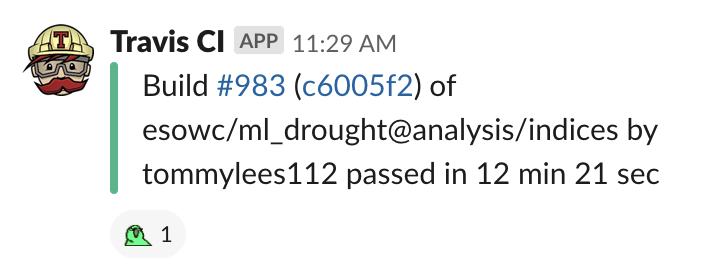A Machine Learning Pipeline for Climate Research

Over the last few weeks, I have been working with Tommy Lees to develop a machine learning pipeline to predict drought, as part of the ECMWF’s Summer of Weather Code program.
As we developed the pipeline, there were a few requirements we wanted to satisfy. The pipeline has to:
- Be easily extensible (to both new features and new data sources), to allow us to experiment with many different ways of predicting drought, since there is no accepted approach.
- Be robust, and thoroughly tested, so that we can be confident the pipeline is doing what we expect.
- Be easy to validate and analyze, so that we can assess the performance of our models and understand what patterns they are learning.
The result consists of 5 steps, which I’ll discuss in more detail:
- Exporters, which download raw data
- Preprocessors, which transform the raw data into a uniform data format
- Engineers, which prepare the inputs to the machine learning models
- (Machine Learning) Models
- Analysis of the model predictions, and of what the models have learnt

Extensibility
The pipeline is split into 2 “halves”, each of which tackle a specific type of extensibility:
Data extensibility
At the front end of the pipeline, we focused on data extensibility; making it easy to incorporate new data sources.
This is achieved by the exporters and the preprocessors: the exporters handle interactions with data stores, and have to be customized for each unique store (e.g. talking to a specific API, or to an FTP).
The preprocessors handle quirks in the data itself (e.g. dimensions named “time1” instead of “time”). In addition, they are responsible for putting all the data onto a uniform spatial and temporal grid; this makes different datasets easy to combine.
Ensuring all the data has the same format means that future steps are decoupled from the data sources. This allows new data sources to be added with the addition of only two classes: an exporter and a preprocessor. Nothing downstream needs to be changed for that new data to be included in experiments.
Experimental extensibility
The back end of the pipeline focuses on experimental extensibility (for instance, experimenting with different machine learning algorithms). The biggest challenge here was balancing ease of use with flexibility.
Using experiments with different machine learning algorithms as an example, we imposed some constraints on different algorithms:
- Most significantly, the engineer is responsible for splitting the training and test datasets. This is to prevent a model from accidentally introducing leakage.
- Each model has access to the same training data format (i.e. a year of data to predict the next timestep). Although this may not be optimal for all models (e.g. RNNs might prefer to predict on a rolling basis) it makes it much easier to alternate between models for experiments.
The training and testing data is stored in NetCDF format to maximize the amount of information available to the models (and therefore the type of models which can be implemented) by ensuring the spatial and temporal grids associated with the data can still be accessed.
Robustness

Particularly when developing a machine learning pipeline, which can often fail silently, we have found it super helpful to use tests to make sure every step does what’s expected.
We use pytest to extensively unit test everything. Beyond just making sure the code works, pytest is really useful in allowing us to communicate what a piece of code is supposed to achieve.
We also use type hints (checked using mypy). In addition to catching bugs, this is another useful way to communicate what a piece of code expects (and what it returns), which makes it easier for us to work on each other’s code.
A little bit of overhead at the beginning of the development process (adding continuous integration and the framework for all the testing) has made it super easy to ensure robustness is baked into our pipeline as we add experiments.
Validation & Analysis
We validate all our models by comparing them to extremely simple models, which we understand well. This is especially useful because - unlike some other applications of machine learning - there aren’t well established baselines for machine learning applied to climate sciences.
The baseline we currently use is a persistence model, which predicts the vegetation health in month N to be vegetation health in month N - 1 (e.g. we predict vegetation health in June to be identical to vegetation health in May). This gives us a good idea of how the models should be performing.
In addition, we have focused on leveraging interpretable machine learning techniques to analyze what the models are learning. This allows us to ensure the patterns being learnt by the models make sense (e.g. data from months close to the month being predicted should be more important to the model’s prediction), and also to better understand the relationship between the input variables and the target variable.
Conclusion
In conclusion, the pipeline we have developed allows us to quickly iterate through different experiments, whilst ensuring the code we are writing is robust.
Analyzing what the machine learning algorithms are learning and validating the models against a very simple baseline allows us to sanity check the entire pipeline, and may allow us to discover new things about the relationships between climate patterns and drought.
The pipeline can be explored at https://github.com/esowc/ml_drought
Please let us know if you have any questions!